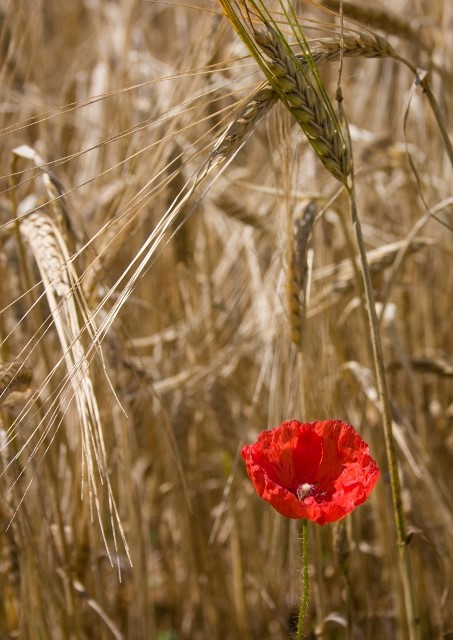
As Pagan Britain became an agricultural community the importance of the harvest increased. Stories are in abundance about the sacrifices of animals and humans to those deities who were feared and reverenced and could ensure a good crop yield. However, there seems little evidence of this practice in Britain.
However, in Phrygia situated between the Mediterranean and the Black sea, a stranger found near the fields at harvest time would be captured in the belief that the corn spirit had entered his body. The victim was then taken into the fields and surrounded by the last sheaves of corn and his head was ritually cut off using sickles. The blood which was believed to contain the corn spirit was then spilt on the earth thus return the spirit to the earth and ensuring the next harvest. (The Golden Bough: J.Fraser)
This is probably where the symbolic willing death of the Corn King or John Barleycorn came into existence. – In the more Mediterranean countries the harvest would have more likely coincided with Lammas, but in Britain, August still finds most farmers with much of the harvest still to complete.
Lughnasad is Lugh’s festival, Lugh being a Sun God and at the height of his power at this time of year. Lammas is derived from the Anglo Saxon “Hlafmaesse” or loaf mass – a festival in which loaves of bread were consecrated. These were made from the first ripe corn. In the middle Ages the harvest itself, the in-gathering remained virtually a heathen festival. Lammas appears to have been a specially Anglo- Saxon occasion which vanished along with many symbolic and beautiful practices at the reformation (Whistler 1947).
A good harvest was always a reason for celebration, and the first cut, fruits etc. were decorated and ceremoniously offered up to the spirit who had dwelt within the seeds throughout the growing season. Often the first offering, sheaf of corn would be set alight as suitable offering.
It seems to have been a generally held belief that the Corn god/spirit took refuge from the farmer’s lethal sickle in the final patch of corn, and it is because of this the ritual practice to fashion the last stalks into a figure, or corn dolly came into being. The corn dolly therefore was a thanks offering for a plentiful harvest safely gathered in, and a talisman to ensure that the following crop would be as plentiful, it was also believed to possess the spirit of the corn which would be kept safe until the time for planting in the following year.
The corn dolly made from the last sheaves of corn was held during the winter months in a safe venue, and at the spring sowing it would be ploughed back into the land to begin the new cycle of growth and to ensure a good harvest.
The customs which surround the corn dolly are plentiful particularly in the British Isles, although they can be found in some form or other across any land where the harvest was the main source of food, and economy.
In Devon up until the 1800’s a corn dolly made from the last row of wheat as a solid column (like a neck) was held with ears of corn pointing upwards. The reapers standing in a circle bowed to the “Nek” or dolly and touched the ears to the ground to make sure that the corn spirit returned to the earth for the following year’s harvest.
In Scotland the corn dolly was a maiden who was carried ceremoniously into the kitchen by one young woman who was especially chosen as the “Queen of the maiden feast”
In West Wales it was a young man who was honoured, while the other lads tried to take the dolly away from him, by throwing water at him and trying in any way to release the dolly from him. If he managed to get home safely then the dolly was left in his keeping for the winter and it was his choice if it were ploughed back into the land or fed to the plough horse in the spring.
Yorkshire called their corn dolly “the dame”
Northumbrian farmers paraded their corn doll on the end of a pole and it lead the procession as they made their way home and she was presented to the winner of a race, run by those that had harvested the field.
Similarities can be seen all over the British countryside, and in many places the last patch is cut by hand. This privilege is given often to the eldest worker, or to one favoured by the others, and he takes the final corn fastening it into a dolly. Again after much jollity the favoured man runs home and is doused by the maids, or one maid. If he returns home with the dolly intact it was put in a safe place, often above the fireplace in the kitchen, where it was safe and secure until the spring.
Other variations of the dolly are the cornucopia (horn of plenty), and other animal type structures. The mare was made in Herefordshire where the farmers would compete to finish their harvesting.
In essence, wherever these customs remained, they can all be seen to primarily acknowledge the corn God/Spirit of the corn, and to keep his essence safe until it was needed again to impregnate the new crops.
Lyn Baylis
Chair of the Pagan Seminary
Committee Member of the Brighton and Hove Interfaith Council
